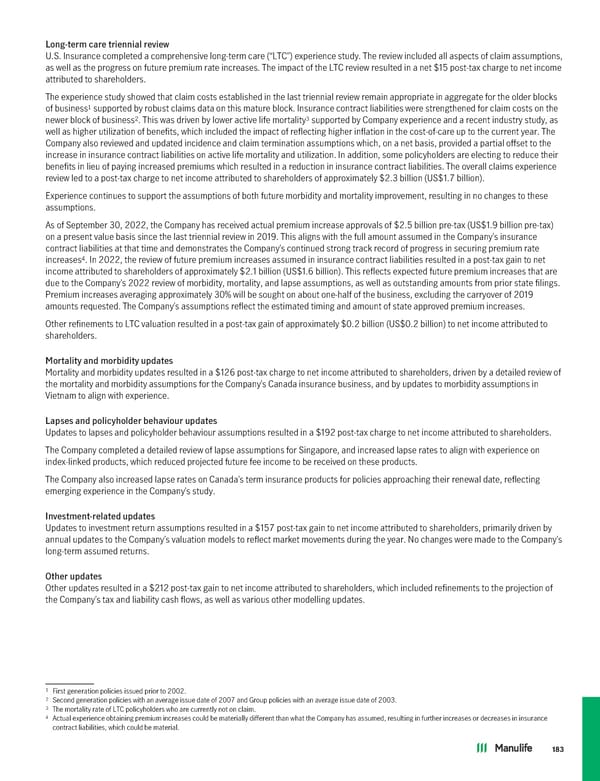Long-term care triennial review U.S. Insurance completed a comprehensive long-term care (“LTC”) experience study. The review included all aspects of claim assumptions, as well as the progress on future premium rate increases. The impact of the LTC review resulted in a net $15 post-tax charge to net income attributed to shareholders. The experience study showed that claim costs established in the last triennial review remain appropriate in aggregate for the older blocks 1 supported by robust claims data on this mature block. Insurance contract liabilities were strengthened for claim costs on the of business 2 3 newer block of business . This was driven by lower active life mortality supported by Company experience and a recent industry study, as well as higher utilization of benefits, which included the impact of reflecting higher inflation in the cost-of-care up to the current year. The Company also reviewed and updated incidence and claim termination assumptions which, on a net basis, provided a partial offset to the increase in insurance contract liabilities on active life mortality and utilization. In addition, some policyholders are electing to reduce their benefits in lieu of paying increased premiums which resulted in a reduction in insurance contract liabilities. The overall claims experience review led to a post-tax charge to net income attributed to shareholders of approximately $2.3 billion (US$1.7 billion). Experience continues to support the assumptions of both future morbidity and mortality improvement, resulting in no changes to these assumptions. As of September 30, 2022, the Company has received actual premium increase approvals of $2.5 billion pre-tax (US$1.9 billion pre-tax) on a present value basis since the last triennial review in 2019. This aligns with the full amount assumed in the Company’s insurance contract liabilities at that time and demonstrates the Company’s continued strong track record of progress in securing premium rate 4 increases . In 2022, the review of future premium increases assumed in insurance contract liabilities resulted in a post-tax gain to net income attributed to shareholders of approximately $2.1 billion (US$1.6 billion). This reflects expected future premium increases that are due to the Company’s 2022 review of morbidity, mortality, and lapse assumptions, as well as outstanding amounts from prior state filings. Premium increases averaging approximately 30% will be sought on about one-half of the business, excluding the carryover of 2019 amounts requested. The Company’s assumptions reflect the estimated timing and amount of state approved premium increases. Other refinements to LTC valuation resulted in a post-tax gain of approximately $0.2 billion (US$0.2 billion) to net income attributed to shareholders. Mortality and morbidity updates Mortality and morbidity updates resulted in a $126 post-tax charge to net income attributed to shareholders, driven by a detailed review of the mortality and morbidity assumptions for the Company’s Canada insurance business, and by updates to morbidity assumptions in Vietnam to align with experience. Lapses and policyholder behaviour updates Updates to lapses and policyholder behaviour assumptions resulted in a $192 post-tax charge to net income attributed to shareholders. The Company completed a detailed review of lapse assumptions for Singapore, and increased lapse rates to align with experience on index-linked products, which reduced projected future fee income to be received on these products. The Company also increased lapse rates on Canada’s term insurance products for policies approaching their renewal date, reflecting emerging experience in the Company’s study. Investment-related updates Updates to investment return assumptions resulted in a $157 post-tax gain to net income attributed to shareholders, primarily driven by annual updates to the Company’s valuation models to reflect market movements during the year. No changes were made to the Company’s long-term assumed returns. Other updates Other updates resulted in a $212 post-tax gain to net income attributed to shareholders, which included refinements to the projection of the Company’s tax and liability cash flows, as well as various other modelling updates. 1 First generation policies issued prior to 2002. 2 Second generation policies with an average issue date of 2007 and Group policies with an average issue date of 2003. 3 The mortality rate of LTC policyholders who are currently not on claim. 4 Actual experience obtaining premium increases could be materially different than what the Company has assumed, resulting in further increases or decreases in insurance contract liabilities, which could be material. 183
 2022 Annual Report Page 184 Page 186
2022 Annual Report Page 184 Page 186